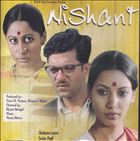
Year:1975
Director: Shyam Benegal
Cast: Girish Karnad, Shabana Aazmi, Naseeruddin Shah, Smita Patil
Shyam Benegal’s Nishant was released in1975- the same year when Hindi cinema (It had not received the famous sobriquet-‘Bollywood’ then!) was basking in the success of its greatest commercial film- Sholay- Ramesh Sippy’s Seven Samurai-inspired revenge drama. The coincidence just further highlighted the value of parallel cinema, which refused to be swept away by conventional box-office norms of larger-than-life portrayals and came up with some path-breaking films dealing maturely with ground realities of life.
Scripted by the famous Marathi playwright Vijay Tendulkar,
Nishant (meaning end of night) told a grim story of a small village’s brutal exploitation by feudal lords and the consequent retaliation. Although the story takes place in an unnamed village in 1945, it has such timeless quality that it could well be happening somewhere even now. Four brothers- a tyrant eldest (Amrish Puri), a meek youngest (Naseerduddin) and two goony middle ones (Mohan Agashe and Anant Nag) are flagrantly using their landlord family’s clout to control everything in their village. The poor peasants are being fleeced and flogged; their wives openly exploited and even the Police Patel (Kulbhushan Kharbanda) has been bought over. The landlords even have the temerity to steal the village temple’s jewelry and framing an innocent man (Sadhu Meher) for it.
The newly arrived school-master (Girish Karnad) becomes the next victims of these feudal atrocities. The brothers kidnap his wife (Shabana Azmi) and make her the keep of the family- all under the silent gaze of suppressed villagers. The school-master tries to seek justice but is given a cold shoulder by the authorities. Can this simple man rise up against his all-too-powerful oppressors? Can his impotent anger lead to a violent rebellion?
Benegal’s direction painstakingly portrays the varied characters and their disturbing social milieu in vivid details. If the four brothers are representing the ugly face and iron hand of feudalism then characters like the pushed- to- the- wall school-master, his spirited wife who finally learns to surrender to kidnappers, the youngest brother’s wife (Smita Patil in her debut role) watching her husband getting drawn to the nabbed woman, the philosophical village-priest and the spineless police- officer are all helpless victims of this centuries-old unjust social tradition. Benegal uses the mythological reference of Seeta –Haran (Abduction of Seeta) and Ravana – Vadh (killing of Ravana) from Ramayana but his violent climax is not just a feel-good victory of good over evil, it has many grey shades and leaves the viewer pondering about complexity of life.
Blessed with brilliant individual performances, Nishant is also riddled with the typical shortcomings of parallel films like being too grim and too slow at times but it is certainly a milestone in Indian cinema that every bit deserves its standing on high pedestal.


